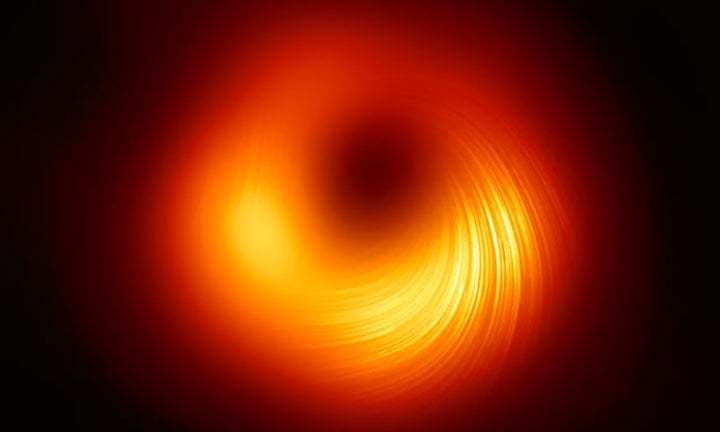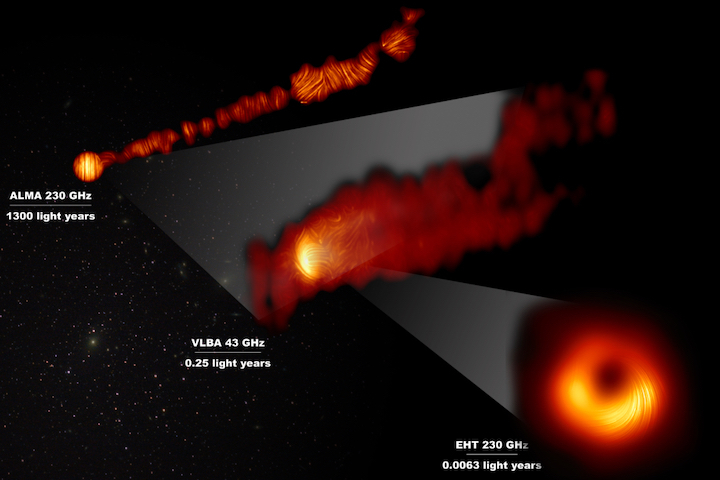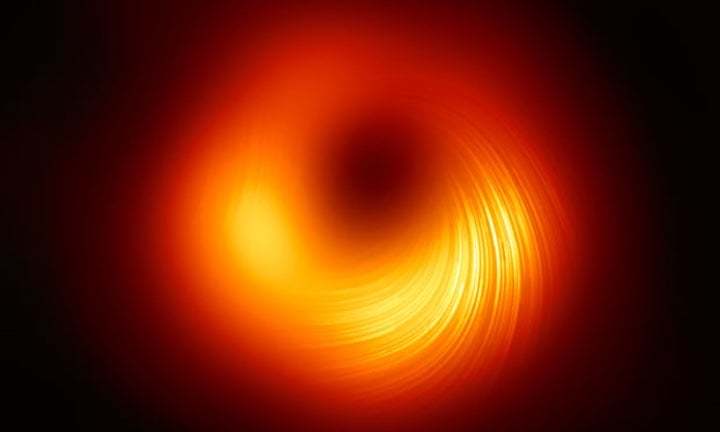An image that captures streaks of polarised light swirling around a supermassive black hole is providing new insight into how galaxies can project streams of energy thousands of light-years outward from their core.
Black holes are places where the pull of gravity is so strong that even light cannot escape. Most surrounding matter gets sucked in, but some particles escape just moments before they are captured and are blown far out into space.
These bright jets of energy and matter are one of the galaxy’s most mysterious features. Researchers suspect the jets are launched and shaped by magnetic fields, but the evidence for this is limited.
The new observations, based on data collected by the Event Horizon Telescope (EHT) collaboration, which links data from eight radio telescopes in various continents to create an Earth-sized virtual telescope, could help to better understand this phenomenon.
“We are now seeing the next crucial piece of evidence to understand how magnetic fields behave around black holes,” said Monika Moscibrodzka, an assistant professor at Radboud University in the Netherlands and co-author of the research, which was published in the Astrophysical Journal Letters.
The EHT collaboration released the first image of a black hole in 2019, revealing a bright ring-like structure with a dark central region described as the black hole’s “shadow”. The black hole is located in a galaxy called Messier 87 (M87), 55m light-years away from Earth.
After capturing that image, the team discovered that a significant fraction of its surrounding light was polarised – meaning its waves are vibrating in one direction only. The light is thought to become polarised when it is emitted in hot regions of space that are magnetised.
Using the same data as for their first image, they have now analysed that polarised light and are using it to map the magnetic field lines at the black hole’s inner edge, and better understand how these fields act to keep hot gas out of the black hole.
Team member Dr Ziri Younsi at the University College London Mullard space science laboratory said: “These groundbreaking measurements of the polarisation of light produced at the edge of the black hole’s event horizon provide us with exciting new insights into the physical processes by which black holes feed on matter, and how they are able to power such prodigious relativistic outflows as astrophysical jets. In particular, they hint at the role played by magnetic fields in these processes.”
The team found that only theoretical models featuring strongly magnetised gas could explain what they were seeing at the event horizon – the boundary marking the limits of a black hole.
Co-author Dr Jason Dexter, at the University of Colorado in Boulder, US, said: “The observations suggest that the magnetic fields at the black hole’s edge are strong enough to push back on the hot gas and help it resist gravity’s pull. Only the gas that slips through the field can spiral inwards to the event horizon.”
Quelle: The Guardian
+++
Harvard, Smithsonian Astronomers Help Capture First Image of Black Hole’s Magnetic Fields

Cambridge, MA – Astronomers have now obtained a new view of the supermassive black hole at the center of galaxy M87. Images released today by the Event Horizon Telescope (EHT) collaboration reveal how the black hole, some 55 million light-years away, appears in polarized light.
The image marks the first time astronomers have captured and mapped polarization, a sign of magnetic fields, so close to the edge of a black hole.
Scientists still don't understand how magnetic fields — areas where magnetism affects how matter moves — influence black hole activity. Do they help direct matter into the hungry mouths of black holes? Can they explain the mysterious jets of energy that extend out of the galaxy's core?
"We are now seeing the next crucial piece of evidence to understand how magnetic fields behave around black holes, and how activity in this very compact region of space can drive powerful jets that extend far beyond the galaxy," says Monika Mościbrodzka, Coordinator of the EHT Polarimetry Working Group and Assistant Professor at Radboud University in the Netherlands
In two studies published today in The Astrophysical Journal Letters, EHT astronomers reveal their latest findings and how magnetic fields may be influencing the black hole at the center of M87.
"One of the main science drivers of the EHT is distinguishing different magnetic field configurations around the black hole," says Angelo Ricarte, a co-author and researcher at the Center for Astrophysics | Harvard & Smithsonian. “Polarization is one of the most direct probes into the magnetic field that nature provides."
The EHT collaboration has been studying the supermassive object at the heart of M87 for well over a decade. In April 2019, the team's hard work paid off when they revealed the very first image of a black hole. Since then, the scientists have delved deeper into the data, discovering that a significant fraction of the light around the M87 black hole is polarized.
Light becomes polarized when it goes through certain filters, like the lenses of polarized sunglasses, or when it is emitted in hot regions of space that are magnetized. In the same way polarized sunglasses help us see better by reducing reflections and glare from bright surfaces, astronomers can sharpen their view of the black hole by looking at how light originating from there is polarized. Specifically, polarization allows astronomers to map the magnetic field lines present around the inner edge of the black hole.
"In order to gain confidence in our analysis, we used as many as five distinct methods to calibrate the data and reconstruct polarimetric images," says Maciek Wielgus, a researcher at Harvard's Black Hole Initiative and the Center for Astrophysics (CfA) who participated in the study. "This huge team effort paid off as we found very good consistency between results obtained with all the different techniques."
"The newly published polarized images are key to understanding the powerful jets that are launched from this region," says EHT Collaboration member Andrew Chael, a Hubble Fellow at the Princeton Center for Theoretical Sciences and the Princeton Gravity Initiative in the U.S.
One of M87's most mysterious features is the bright jet of matter and energy that emerges from its core and extends at least 100,000 light years away. Most matter lying close to the edge of a black hole falls in. However, some of the surrounding particles escape moments before capture and are blown far out into space in the form of these jets.
Astronomers don't know how jets larger than the galaxy itself are launched from its core, nor how only certain matter falls into the black hole.
Now, with the new image of the black hole in polarized light, the team has looked directly into the region just outside the black hole where this interplay between inflowing and ejected matter occurs.
The observations provide new information about the structure of the magnetic fields just outside the black hole, revealing that only theoretical models featuring strongly magnetized gas can explain what astronomers are seeing at the event horizon.
"Magnetic fields are theorized to connect black holes to the hot plasma surrounding them," says Daniel Palumbo, a co-author and researcher at the Center for Astrophysics. "Understanding the structure of these fields is the first step in understanding how energy can be extracted from spinning black holes to produce powerful jets."
To observe the heart of the M87 galaxy, the EHT collaboration linked eight telescopes around the world, including the Smithsonian Astrophysical Observatory's Submillimeter Array, to create a virtual Earth-sized telescope. The impressive resolution obtained with the EHT is equivalent to that needed to image a credit card on the surface of the Moon.
This unprecedented resolving power allowed the team to directly observe the black hole with polarized light, revealing the presence of a structured magnetic field near the event horizon.
"This first polarized image of the black hole in M87 is just the beginning," says Dominic Pesce, CfA researcher and study co-author. "As the EHT continues to grow, future observations will refine the picture and allow us to study how the magnetic field structure changes with time."
Sheperd Doeleman, founding director of the EHT, added, "Even now we are designing a next-generation EHT that will allow us to make the first black hole movies. Stay tuned for true black hole cinema."
The EHT collaboration involves more than 300 researchers from across the globe and includes 30 scientists and engineers at the Center for Astrophysics | Harvard & Smithsonian.
About the Event Horizon Telescope (EHT) Collaboration
The EHT collaboration involves more than 300 researchers from Africa, Asia, Europe, North and South America. The international collaboration is working to capture the most detailed black hole images ever obtained by creating a virtual Earth-sized telescope. Supported by considerable international investment, the EHT links existing telescopes using novel systems — creating a fundamentally new instrument with the highest angular resolving power that has yet been achieved.
The individual telescopes involved are: ALMA, APEX, the IRAM 30-meter Telescope, the IRAM NOEMA Observatory, the James Clerk Maxwell Telescope, the Large Millimeter Telescope, the Submillimeter Array, the Submillimeter Telescope, the South Pole Telescope, the Kitt Peak Telescope and the Greenland Telescope.
The EHT consortium consists of 13 stakeholder institutions: the Academia Sinica Institute of Astronomy and Astrophysics, the University of Arizona, the Center for Astrophysics | Harvard & Smithsonian, the University of Chicago, the East Asian Observatory, Goethe-Universitaet Frankfurt, Institut de Radioastronomie Millimétrique, Large Millimeter Telescope, Max Planck Institute for Radio Astronomy, MIT Haystack Observatory, National Astronomical Observatory of Japan, Perimeter Institute for Theoretical Physics and Radboud University.
Quelle: Center for Astrophysics | Harvard & Smithsonian
+++
New Images Reveal Magnetic Structures Near Supermassive Black Hole

new view of the region closest to the supermassive black hole at the center of the galaxy Messier 87 (M87) has shown important details of the magnetic fields close to the black hole and hints about how powerful jets of material can originate in that region.
A worldwide team of astronomers using the Event Horizon Telescope, a collection of eight telescopes, including the Atacama Large Millimeter/submillimeter Array (ALMA) in Chile, measured a signature of magnetic fields — called polarization — around the black hole. Polarization is the orientation of the electric fields in light and radio waves and it can indicate the presence and alignment of magnetic fields.
“We are now seeing the next crucial piece of evidence to understand how magnetic fields behave around black holes, and how activity in this very compact region of space can drive powerful jets,” said Monika Mościbrodzka, Coordinator of the EHT Polarimetry Working Group and Assistant Professor at Radboud University in the Netherlands.
New images with the EHT and ALMA allowed scientists to map magnetic field lines near the edge of M87’s black hole. That same black hole is the first ever to be imaged — by the EHT in 2019. That image revealed a bright ring-like structure with a dark central region — the black hole’s shadow. The newest images are a key to explaining how M87, 50 million light-years from Earth, can launch energetic jets from its core.
The black hole at M87’s center is more than 6 billion times more massive than the Sun. Material drawn inward forms a rotating disk — called an accretion disk — closely orbiting the black hole. Most of the material in the disk falls into the black hole, but some surrounding particles escape and are ejected far out into space in jets moving at nearly the speed of light.
“The newly published polarized images are key to understanding how the magnetic field allows the black hole to ‘eat’ matter and launch powerful jets,” said Andrew Chael, a NASA Hubble Fellow at the Princeton Center for Theoretical Science and the Princeton Gravity Initiative in the U.S.
The scientists compared the new images that showed the magnetic field structure just outside the black hole with computer simulations based on different theoretical models. They found that only models featuring strongly magnetized gas can explain what they are seeing at the event horizon.
“The observations suggest that the magnetic fields at the black hole’s edge are strong enough to push back on the hot gas and help it resist gravity’s pull. Only the gas that slips through the field can spiral inwards to the event horizon,” explained Jason Dexter, Assistant Professor at the University of Colorado Boulder and Coordinator of the EHT Theory Working Group.
To make the new observations, the scientists linked eight telescopes around the world — including ALMA — to create a virtual Earth-sized telescope, the EHT. The impressive resolution obtained with the EHT is equivalent to that needed to measure the length of a credit card on the surface of the Moon.
This resolution allowed the team to directly observe the black hole shadow and the ring of light around it, with the new image clearly showing that the ring is magnetized. The results are published in two papers in the Astrophysical Journal Letters by the EHT collaboration. The research involved more than 300 researchers from multiple organizations and universities worldwide.
A third paper also was published in the same volume of the Astrophysical Journal Letters, based on data from ALMA, lead by Ciriaco Goddi, a scientist at Radboud University and Leiden Observatory, the Netherlands.
“The combined information from the EHT and ALMA allowed scientists to investigate the role of magnetic fields from the vicinity of the event horizon to far beyond the core of the galaxy, along its powerful jets extending thousands of light-years,” Goddi said.
The National Radio Astronomy Observatory is a facility of the National Science Foundation, operated under cooperative agreement by Associated Universities, Inc.
The EHT collaboration involves more than 300 researchers from Africa, Asia, Europe, North and South America. The international collaboration is working to capture the most detailed black hole images ever obtained by creating a virtual Earth-sized telescope. Supported by considerable international investment, the EHT links existing telescopes using novel systems — creating a fundamentally new instrument with the highest angular resolving power that has yet been achieved.
The individual telescopes involved are: ALMA, APEX, the Institut de Radioastronomie Millimetrique (IRAM) 30-meter Telescope, the IRAM NOEMA Observatory, the James Clerk Maxwell Telescope (JCMT), the Large Millimeter Telescope (LMT), the Submillimeter Array (SMA), the Submillimeter Telescope (SMT), the South Pole Telescope (SPT), the Kitt Peak Telescope, and the Greenland Telescope (GLT).
The EHT consortium consists of 13 stakeholder institutes: the Academia Sinica Institute of Astronomy and Astrophysics, the University of Arizona, the University of Chicago, the East Asian Observatory, Goethe-Universitaet Frankfurt, Institut de Radioastronomie Millimétrique, Large Millimeter Telescope, Max Planck Institute for Radio Astronomy, MIT Haystack Observatory, National Astronomical Observatory of Japan, Perimeter Institute for Theoretical Physics, Radboud University and the Smithsonian Astrophysical Observatory.
The Atacama Large Millimeter/submillimeter Array (ALMA), an international astronomy facility, is a partnership of ESO, the U.S. National Science Foundation (NSF) and the National Institutes of Natural Sciences (NINS) of Japan in cooperation with the Republic of Chile. ALMA is funded by ESO on behalf of its Member States, by NSF in cooperation with the National Research Council of Canada (NRC) and the Ministry of Science and Technology (MOST) and by NINS in cooperation with the Academia Sinica (AS) in Taiwan and the Korea Astronomy and Space Science Institute (KASI). ALMA construction and operations are led by ESO on behalf of its Member States; by the National Radio Astronomy Observatory (NRAO), managed by Associated Universities, Inc. (AUI), on behalf of North America; and by the National Astronomical Observatory of Japan (NAOJ) on behalf of East Asia. The Joint ALMA Observatory (JAO) provides the unified leadership and management of the construction, commissioning and operation of ALMA.
Quelle: NRAO

